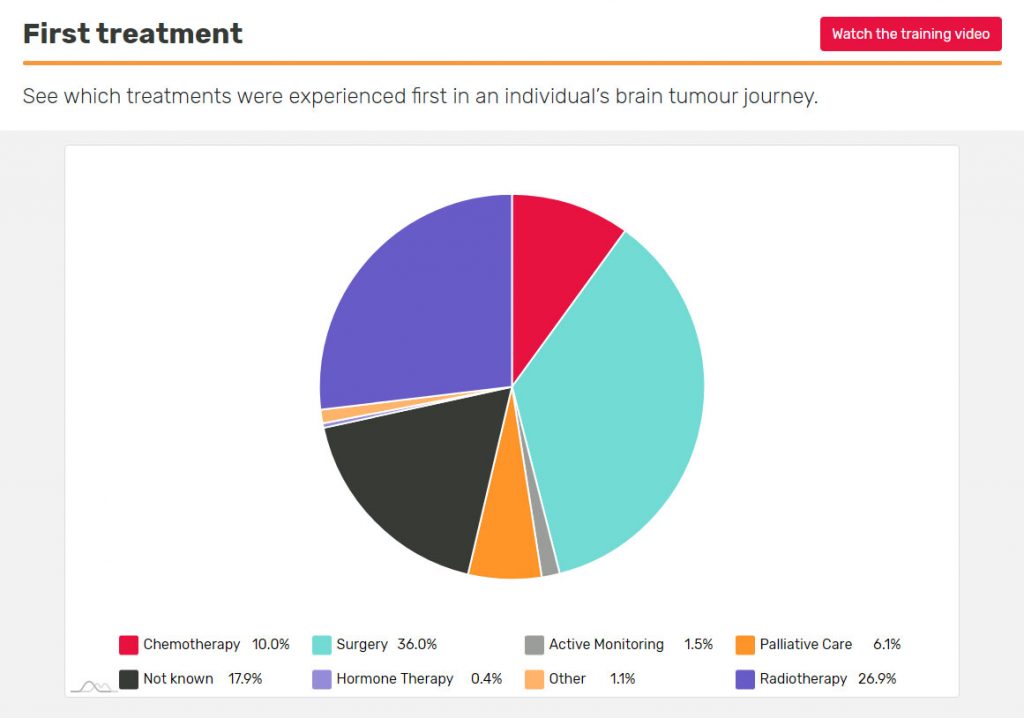Vestibular schwannoma (acoustic neuroma)
Vestibular schwannoma, also known as acoustic neuroma, is a type of low grade brain tumour that mostly affects adults. Vestibular schwannomas, account for 8% of all primary brain tumours.
Short summary
Vestibular schwannomas, or acoustic neuromas, are brain tumours that usually form in the nerves between the ear and the brain. These tumours are low grade, which means they’re not cancerous.
Vestibular schwannomas can affect people of all ages. But, they mostly affect people between the ages of 40 and 60.
Symptoms can include loss of hearing, ringing in the ear, loss of balance, headaches, and blurred vision.
Treatment for vestibular schwannomas can range from ‘watch and wait’ to surgery and radiotherapy.
On this page we’ll cover:
- What is a vestibular schwannoma?
- Vestibular schwannoma symptoms
- What causes vestibular schwannoma?
- How are vestibular schwannomas diagnosed?
- How is a vestibular schwannoma treated?
- Vestibular schwannoma life expectancy
Get support
It’s normal to feel shocked if you or someone you know has been diagnosed with a brain tumour. Our Support Team can answer questions you have or provide a listening ear if you need one.
Get your free Information Pack
Our Brain Tumour Information Pack can help you better understand your diagnosis and feel confident talking to your medical team.
Get the BRIAN app
BRIAN is our trusted online app where you can track your experience, compare it with others who’ve been there and get the knowledge you need to make informed decisions.
What is a vestibular schwannoma?
Vestibular schwannomas (also sometimes called acoustic neuromas) are slow-growing tumours. They are low grade, which means they are non-cancerous, or benign.
They usually occur in the vestibular division of the eighth cranial nerve (known as the acoustic or vestibulocochlear nerve).
Cranial nerves are large nerves that control movement and sensation in the face, head and other parts of the body.
Schwannomas can also occur in the spinal nerves, which connect the spinal cord with the nerves outside of the brain and spinal cord.
Schwannomas develop from Schwann cells, which are cells on the outside of nerves. They wrap myelin around the nerves, which allows impulses to travel quickly along them.
These tumours affect people of all ages, but are most common in people between the ages of 40 and 60.
More than 90% of vestibular schwannomas occur in people without a history of these tumours in their family.
Vestibular schwannoma symptoms
Common vestibular schwannoma symptoms are:
- Hearing loss, which gets worse over time
- Ringing in the ear (on one or both sides)
- Sensation of feeling off balance, of moving or spinning of the environment (vertigo).
Larger tumours may cause neurological side effect, but they are less frequent. These could be:
- Headache
- Facial pain
- Hydrocephalus which leads to a wide range of symptoms from the increased intracranial pressure (i. e. nausea and vomiting, blurred vision, difficulty walking).
What causes vestibular schwannomas?
It’s important to know that there is nothing you could have done, or avoided doing, that would have caused you or somebody you know to develop a brain tumour.
As with other brain tumours, the cause of most vestibular schwanomma is unknown, but there is an understanding that genetics can be involved.
Although most of the vestibular schwannomas occur in people without a history of these tumours in their family, some tumours are related to a genetic disorder called Neurofibromatosis type 2 (NF2).
-
NF-2 is a genetic condition that causes low grade tumours to grow along your nerves. It’s caused by a permanent change (mutation) in a gene that makes the growth of nerve tissue become uncontrolled. In half of all cases of NF-2, the mutation is passed from parent to child. There are genetic tests that can be carried out during pregnancy to test whether your child will have NF-2, but it’s normally diagnosed after birth.
How are vestibular schwannomas diagnosed?
Vestibular schwannoma diagnosis can be difficult as their symptoms can be similar to other conditions. For example, hearing loss might be put down to age or exposure to high levels of noise earlier in life.
Vestibular schwannomas are usually diagnosed after:
- routine auditory tests to reveal any loss of hearing and speech decline
- an audiogram to evaluate the level of hearing in both ears
- tests to check your sense of balance, reflexes and the strength in your arms and legs
- a diagnostic scan (usually an MRI), if there’s a noticeable loss of hearing in one ear.
How is a vestibular schwannoma treated?
Conservative (watch and wait)
Some vestibular schwannomas may not need immediate treatment. This is usually when they are small and not causing symptoms.
If this is the case, you’ll usually be put on active monitoring (also called “watch and wait”) and you’ll see your specialist for regular check-ups or MRI scans.
Surgery for vestibular schwannomas
Neurosurgery is usually only used to remove larger vestibular schwannoma brain tumours as it can result in the loss of hearing in the affected ear.
Your surgeon will explain what is involved in the procedure and potential risks and complications. The surgeon may leave a small part of the tumour to prevent damage to the facial nerve. Any tumour cells that are left behind can be treated with stereotactic radiosurgery.
You may wish to discuss the possibility of having a ‘bone anchored hearing aid’ with your surgeon. This diverts sound from your affected ear to your good ear.
Occasionally surgery can result in damage to the facial nerve, causing your face to droop on one side or difficulty in closing that eye.
Radiotherapy
Radiotherapy uses beams of radiation to try to destroy tumour cells.
Some patients may benefit with this treatment. The main aim of radiotherapy is to prevent tumour growth. Stereotactic radiotherapy is the most used.
Emerging treatments
As the knowledge of vestibular schwannoma grows, targeted therapies are emerging.
Clinical trials are being conducted using Bevacizumab, Everolimus and Lapatinib as potential options for treating vestibular schwannomas.
Vestibular schwanommas very rarely return after surgery, but you may continue to have regular MRI scans.
Even with treatment, symptoms such as tinnitus and hearing loss can persist. These symptoms will require additional treatment.
What treatment do people diagnosed with an acoustic neuroma have first?
If you’ve just been diagnosed with one of these tumours and are about to have treatment, you may want to see what other people’s first treatment was. Use the First Treatment insight in BRIAN, which you can personalise to make it relevant to you.

Vestibular schwannoma life expectancy
Vestibular schwannomas are rarely life-threatening. This is because they are relatively uncommon and are usually slow-growing.
Also, as we mentioned above, some of these tumours might not need to be treated right away, while others can be treated with surgery and stereotactic radiosurgery.
Because of the nature of the tumours themselves and the treatments available, the acoustic neuroma life expectancy for people affected is quite promising. With their symptoms being checked regularly by a qualified doctor, most people with these tumours can live normal lives for many years.
Get support
If you would like to find out more information about these brain tumours, or you’d like to talk to someone about how you’re feeling, our kind and approachable Support Team is here to help you.
You can also join our Health Unlocked support group for acoustic neuromas.
Support and Information Services
Research & Clinical Trials Information
You can also join our active online community.
In this section

Get support
If you need someone to talk to or advice on where to get help, our Support and Information team is available by phone, email or live-chat.
